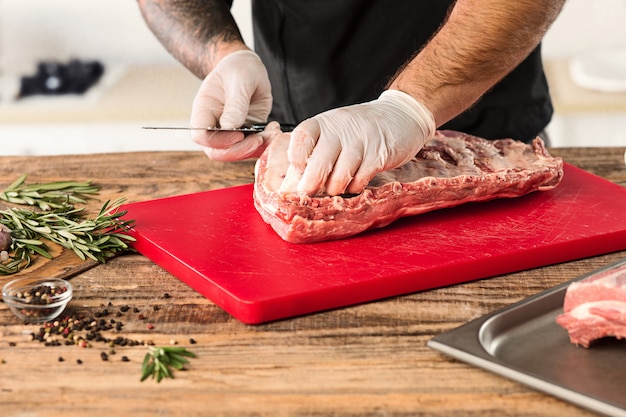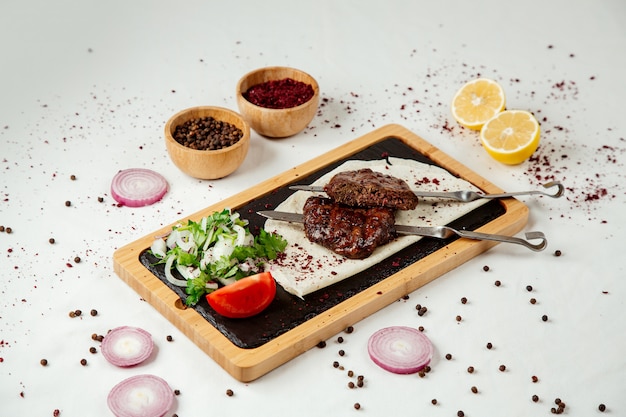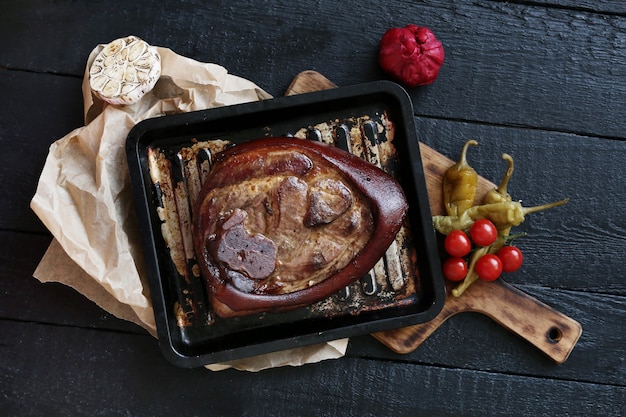Forget the fancy cuts! Let's talk about chuck steak, a workhorse of the meat world that often gets overlooked. It's packed with flavour, and with a bit of know-how, you can transform this tough cut into a truly delicious meal. I've been cooking for years, and I've learned a thing or two about getting the most out of this versatile piece of beef. In this guide, I'm spilling my secrets, from choosing the right cut to mastering the perfect cooking techniques. So, grab a cuppa, settle in, and let's get started!
(Part 1) Choosing the Right Chuck Steak: The Foundation of Flavor

The first step to a delicious chuck steak dish is choosing the right cut. Think of it as building a house – you need a solid foundation. You want a cut that has a good amount of marbling, those little streaks of fat woven throughout the meat. Marbling is key! It adds flavour, keeps the steak moist while cooking, and gives it that melt-in-your-mouth texture we all crave. If you're looking for a leaner option, a chuck eye roast is a good choice, but for maximum flavour, I always recommend a chuck roast or a chuck flap steak.
Key Points for Picking Your Steak:
Here are a few pointers to help you pick the best chuck steak for your needs:
- Marbling Matters: The more marbling, the richer the flavour and the more tender your steak will be. Look for a nice even distribution of fat throughout the meat.
- Feel for Firmness: The meat should feel firm and springy to the touch. If it feels mushy or slimy, that's a sign it might not be fresh.
- Colour Counts: A good chuck steak should be a deep, vibrant red colour. If it's brown or grey, it's probably not fresh and you should steer clear.
- Don't Be Shy, Ask for Help: Butchers are experts in their field! They're happy to guide you towards the perfect cut for your needs. Just tell them what you're planning to cook, and they can help you make the best choice.
(Part 2) Preparing Your Chuck Steak: Taming the Toughness

Once you've got your chuck steak, it's time to prep it for cooking. Now, I know what you're thinking - chuck steak can be a bit tough, right? That's where the tenderizing magic comes in. A little bit of effort goes a long way! Think of it as a workout for your meat – it'll reward you with tender results.
Tenderizing Techniques:
There are a few tried-and-true methods for tenderizing chuck steak. Here are a few of my favorites:
- The Trusty meat mallet: This is a classic for a reason. Give your steak a few good whacks with a meat mallet to break down those tough muscle fibres. Just don't go overboard, or you'll end up with mince instead of a steak!
- Salt and Pepper Magic: Sprinkle your steak generously with salt and pepper, and then let it sit in the fridge for at least an hour. The salt helps to draw out moisture, which tenderizes the meat, and the pepper adds a burst of flavor.
- The Marinade Miracle: Marinades are your secret weapon for adding flavor and tenderizing your steak. A simple marinade of olive oil, vinegar, and herbs can work wonders. Leave it for a few hours or even overnight for the best results.
You might be wondering, "Why go through all this tenderizing?" It's all about getting that perfect texture. When you cook chuck steak, the goal is to break down those tough muscle fibers so you end up with a tender, juicy result that melts in your mouth.
(Part 3) The Low and Slow Approach: Mastering the Art of Braising

Now, let's talk about the cooking technique that truly transforms chuck steak – braising. It's a slow and gentle method that takes a tough cut and turns it into something incredibly tender and flavorful.
Braising Basics:
Braising is all about cooking your steak in liquid, usually in a covered pot or dutch oven, over low heat for an extended period. The liquid keeps the meat moist and tender, while the low heat allows the tough muscle fibers to break down completely. It's like a slow cooker on steroids, but with a touch of finesse.
- Start with a Searing Sensation: This step is essential! A good sear adds incredible flavour and colour to your steak. Get a nice, hot pan going, and sear the steak on all sides until it's golden brown and crispy.
- Choose Your Braising Liquid: You have endless options for your braising liquid! From wine to broth to beer, you can choose whatever suits your taste and your meal. I love a mix of red wine and beef broth for a rich, flavourful sauce that's truly delicious.
- Add Your Veggie Ensemble: Braising is a great way to cook vegetables too! Toss in carrots, onions, celery, or mushrooms to your pot. They'll add flavour and colour to your sauce and become deliciously tender as they cook.
- Cover and Simmer: Once everything is in the pot, cover it tightly and simmer over low heat for at least 2 hours, or until the steak is incredibly tender. The longer you simmer, the more tender your steak will become.
- The Resting Game: After the steak is cooked, let it rest for 15 minutes before slicing it. This gives the juices time to redistribute, making it even more tender and juicy.
The beauty of braising is that it's incredibly forgiving. You can use whatever vegetables you have on hand, and you don't need to be precise with the cooking time. Just let the steak simmer away until it reaches that perfect level of tenderness.
(Part 4) The Power of Flavour: Creating Delicious Braising Sauces
Speaking of flavour, let's talk about braising sauces. These are the magic that takes your chuck steak from good to unforgettable! They're packed with deliciousness and can be adapted to suit any taste.
Sauce Secrets:
Here are a few tips for making the most delicious braising sauces:
- Start with a Flavorful Base: As I mentioned, a mix of red wine and beef broth is a classic choice. But don't be afraid to explore! You can also use chicken broth, vegetable broth, or even beer.
- Add Aromatic Depth: Aromatics like onions, garlic, and herbs add incredible depth and complexity to your sauce. Don't be afraid to experiment with different combinations. Try a classic mirepoix (carrots, celery, onions) for a base, or add a touch of rosemary, thyme, or bay leaves for a more aromatic sauce.
- Spices: The Secret Weapon: Spices like paprika, cumin, oregano, and thyme can really elevate the flavour of your braising sauce. A pinch of chili powder can add a kick of heat, or a touch of smoked paprika can give your sauce a smoky depth.
- Thicken It Up: If your sauce is a bit thin, you can thicken it up with a cornstarch slurry or a simple flour roux. A cornstarch slurry is simply cornstarch mixed with cold water, and a flour roux is made by cooking butter and flour together. Both will thicken your sauce nicely.
- Taste and Adjust: The most important thing is to taste your sauce as you go. Adjust the seasoning to your liking. You want the sauce to be perfectly balanced, with the right amount of salt, pepper, and other spices.
The beauty of braising sauces is that you can get really creative. You can make a classic red wine sauce, a rich and creamy mushroom sauce, or even a spicy tomato sauce. It's all up to you!
(Part 5) The Chuck Steak Showdown: Braising vs. slow cooking
Now, I know some of you might be thinking, "Why go through all this effort when you can just chuck it in a slow cooker?" Well, I'm not saying slow cooking is bad, but for me, braising delivers a level of flavour and texture that's simply unmatched. It's like the difference between a good cup of tea and a proper afternoon tea - both enjoyable, but one takes it to another level.
Braising vs. Slow Cooking:
Here's a breakdown of the pros and cons of each method:
| Method | Pros | Cons |
|---|---|---|
| Braising |
|
|
| Slow Cooking |
|
|
Ultimately, the best method for you depends on your preferences and your schedule. If you have the time and the desire to create a truly exceptional meal, braising is the way to go. If you're looking for a simple, hands-off option, then slow cooking is perfect.
(Part 6) Beyond the Basic Braise: Exploring Other Cooking Methods
While braising is my go-to method for chuck steak, it's not the only way to cook it. This versatile cut of meat can handle a whole range of cooking techniques, from grilling to stir-frying. Let's explore some alternatives, shall we?
Alternative Cooking Methods:
- Grilling: Yes, you can grill chuck steak! It's best to cut it into thin slices and marinate it before grilling. Just make sure your grill is hot and cook it over medium heat for about 4-5 minutes per side. You can also try grilling it over indirect heat for a more even cook.
- Pan-frying: This is a great way to get a crispy crust on your chuck steak. Cut it into thin slices, season it generously, and pan-fry it over medium-high heat for about 3-4 minutes per side. Be sure to use a heavy-bottomed pan to ensure even cooking.
- Stir-frying: Chuck steak can also be stir-fried, just like other tough cuts of meat. Cut it into small pieces and stir-fry it with your favourite vegetables and sauce. The high heat will quickly tenderize the meat and create a delicious stir-fry.
- Slow cooking: I mentioned it before, but I know some of you are die-hard slow cooker fans, and I get it! Slow cooking is a great way to make chuck steak incredibly tender. Just make sure you use a flavorful liquid and cook it on low for at least 6-8 hours.
So, don't be afraid to experiment! Try different cooking methods and see which ones you enjoy the most. You might discover a new favorite way to cook chuck steak.
(Part 7) chuck steak recipes: Inspiration for Every Occasion
Okay, let's get down to business and talk about some recipes. You've got the knowledge, now it's time to put it into practice! I've gathered a few of my favourite chuck steak recipes, from classic comfort food to more adventurous dishes.
Chuck Steak Recipe Ideas:
- Classic Beef Stew: This is a hearty and satisfying dish that's perfect for a cold winter night. Chuck steak is the perfect cut for stew, and it's easy to make. You can use a variety of vegetables, such as carrots, celery, potatoes, and onions, and a flavorful broth for a truly comforting meal.
- Slow Cooker BBQ Beef: This is a crowd-pleasing recipe that's perfect for a weekend gathering. Chuck steak is incredibly flavorful when slow-cooked in a bbq sauce. You can use your favorite BBQ sauce, or create your own blend of spices and sweet ingredients for a unique flavor.
- One-Pot Beef and Broccoli: This is a quick and easy meal that's perfect for a busy weeknight. Chuck steak is a great base for this dish, and you can add your favorite vegetables. The one-pot aspect makes for easy cleanup, too!
- Beef and Guinness Pie: This is a traditional British dish that's packed with flavor. Chuck steak is the perfect cut for this pie, and the Guinness adds a rich, savory depth. The creamy mashed potato topping makes it a truly indulgent meal.
- Asian-Inspired Stir-Fry: Chuck steak can be used in a variety of Asian-inspired stir-fries. The key is to cut it into thin slices and stir-fry it with your favourite vegetables and sauce. You can use a sweet and sour sauce, a teriyaki sauce, or a peanut sauce for a delicious and flavorful stir-fry.
These are just a few ideas to get you started. Don't be afraid to experiment with different recipes and flavours. The possibilities are endless!
(Part 8) Chuck steak storage and Leftovers: Tips and Tricks
Alright, let's talk about storing your chuck steak properly. This is crucial for keeping it fresh and tasty.
Storage Tips:
- Refrigeration: Store your chuck steak in the coldest part of your fridge, wrapped tightly in plastic wrap or aluminum foil. It should stay fresh for 3-5 days.
- Freezing: If you want to freeze your chuck steak, wrap it tightly in plastic wrap and then place it in a freezer-safe bag. It can be frozen for up to 3-4 months. Just be sure to thaw it in the fridge overnight before cooking.
Leftover Magic:
Speaking of leftovers, don't throw them away! Chuck steak is a fantastic ingredient for all sorts of leftover dishes. Here are a few ideas:
- Chuck Steak Sandwiches: Slice up the leftover chuck steak and use it to make delicious sandwiches. You can add your favorite toppings, such as cheese, lettuce, tomato, and onion.
- Beef Salad: Chop up the leftover chuck steak and use it in a salad. You can add other ingredients, such as lettuce, tomato, cucumber, and cheese.
- Beef Soup: Throw the leftover chuck steak into a pot of soup. You can add other vegetables, such as carrots, celery, and potatoes.
- Beef Hash: Mix the leftover chuck steak with potatoes, onions, and peppers, and fry it all up together.
- Beef Quesadillas: Slice up the leftover chuck steak and add it to quesadillas with your favorite cheese, salsa, and other toppings.
The possibilities are endless! Just get creative and use those leftovers to make something delicious.
FAQs: Your Chuck Steak Questions Answered
Now, I'm sure you've got some questions. Here are some common ones, along with my answers:
1. Is Chuck Steak a Good Cut for Grilling?
It can be, but it's best for thinner cuts. For a thicker steak, you'll need to tenderize it first, or go for a different cut altogether. A chuck flap steak or a chuck eye roast might be better choices for grilling.
2. What About Chuck Steak for Stir-Frying?
Absolutely! Chuck steak works well in stir-fries because it holds up to the high heat and quickly becomes tender. Just make sure you cut it into small pieces so it cooks evenly.
3. What's the Best Way to Know When Chuck Steak is Done?
A meat thermometer is your best friend! For a braised chuck steak, you're looking for an internal temperature of 190-195 degrees Fahrenheit. For other cooking methods, you might need a different temperature, so consult a reliable recipe.
4. Can I Use Chuck Steak for Ground beef recipes?
You can, but it's not ideal. Chuck steak is a tough cut, so it won't grind as smoothly as a more tender cut like sirloin. It's best to go for a cut specifically designed for grinding if you want a really smooth ground beef.
5. Is Chuck Steak Healthy?
Like any cut of meat, moderation is key! Chuck steak is a good source of protein and iron, but it's also high in fat. Choose leaner cuts, trim any visible fat, and cook it in a healthy way. You can also balance it out with plenty of vegetables and whole grains in your meals.
There you have it! My complete guide to cooking chuck steak. I hope this has helped you gain some confidence in tackling this versatile cut of beef. Remember, the key is to embrace the slow and steady approach, get creative with your flavours, and enjoy the delicious results. Happy cooking!
Everyone is watching

Prime Rib Roast Cooking Time Chart: Per Pound Guide
Cooking TipsPrime rib roast. Just the name conjures images of lavish dinners, crackling fires, and hearty laughter. It’s ...

How Long to Bake Potatoes in the Oven (Perfect Every Time)
Cooking TipsBaked potatoes are a staple in my kitchen. They're incredibly versatile, delicious, and surprisingly easy to m...

Perfect Rice Every Time: The Ultimate Guide to Cooking Rice
Cooking TipsAs a self-proclaimed foodie, I've always been a bit obsessed with rice. It's the foundation of countless cuisi...

The Ultimate Guide to Cooking Asparagus: Tips, Techniques, and Recipes
Cooking TipsAsparagus. The mere mention of this spring delicacy conjures up images of vibrant green spears, crisp and burs...

Ultimate Guide to Cooking the Perfect Thanksgiving Turkey
Cooking TipsThanksgiving. Just the word conjures up images of overflowing tables laden with delicious food, the scent of r...
